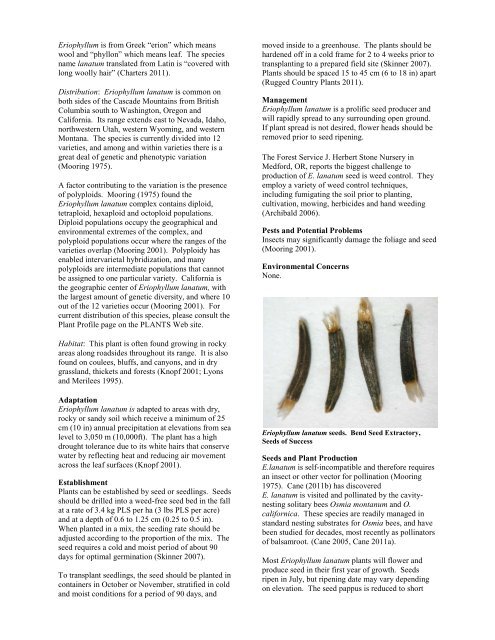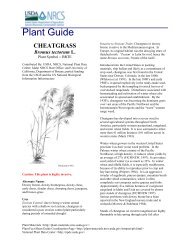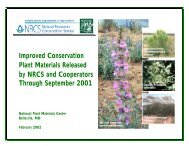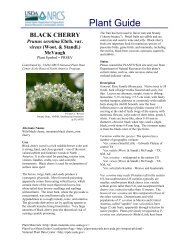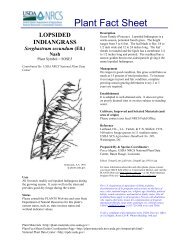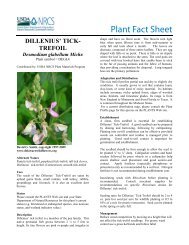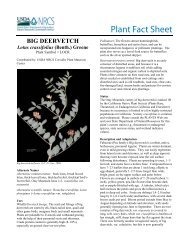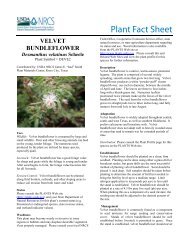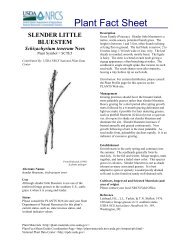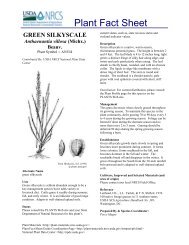Common Wooly Sunflower Plant Guide - USDA Plants Database
Common Wooly Sunflower Plant Guide - USDA Plants Database
Common Wooly Sunflower Plant Guide - USDA Plants Database
Create successful ePaper yourself
Turn your PDF publications into a flip-book with our unique Google optimized e-Paper software.
Eriophyllum is from Greek “erion” which means<br />
wool and “phyllon” which means leaf. The species<br />
name lanatum translated from Latin is “covered with<br />
long woolly hair” (Charters 2011).<br />
Distribution: Eriophyllum lanatum is common on<br />
both sides of the Cascade Mountains from British<br />
Columbia south to Washington, Oregon and<br />
California. Its range extends east to Nevada, Idaho,<br />
northwestern Utah, western Wyoming, and western<br />
Montana. The species is currently divided into 12<br />
varieties, and among and within varieties there is a<br />
great deal of genetic and phenotypic variation<br />
(Mooring 1975).<br />
A factor contributing to the variation is the presence<br />
of polyploids. Mooring (1975) found the<br />
Eriophyllum lanatum complex contains diploid,<br />
tetraploid, hexaploid and octoploid populations.<br />
Diploid populations occupy the geographical and<br />
environmental extremes of the complex, and<br />
polyploid populations occur where the ranges of the<br />
varieties overlap (Mooring 2001). Polyploidy has<br />
enabled intervarietal hybridization, and many<br />
polyploids are intermediate populations that cannot<br />
be assigned to one particular variety. California is<br />
the geographic center of Eriophyllum lanatum, with<br />
the largest amount of genetic diversity, and where 10<br />
out of the 12 varieties occur (Mooring 2001). For<br />
current distribution of this species, please consult the<br />
<strong>Plant</strong> Profile page on the PLANTS Web site.<br />
Habitat: This plant is often found growing in rocky<br />
areas along roadsides throughout its range. It is also<br />
found on coulees, bluffs, and canyons, and in dry<br />
grassland, thickets and forests (Knopf 2001; Lyons<br />
and Merilees 1995).<br />
Adaptation<br />
Eriophyllum lanatum is adapted to areas with dry,<br />
rocky or sandy soil which receive a minimum of 25<br />
cm (10 in) annual precipitation at elevations from sea<br />
level to 3,050 m (10,000ft). The plant has a high<br />
drought tolerance due to its white hairs that conserve<br />
water by reflecting heat and reducing air movement<br />
across the leaf surfaces (Knopf 2001).<br />
Establishment<br />
<strong>Plant</strong>s can be established by seed or seedlings. Seeds<br />
should be drilled into a weed-free seed bed in the fall<br />
at a rate of 3.4 kg PLS per ha (3 lbs PLS per acre)<br />
and at a depth of 0.6 to 1.25 cm (0.25 to 0.5 in).<br />
When planted in a mix, the seeding rate should be<br />
adjusted according to the proportion of the mix. The<br />
seed requires a cold and moist period of about 90<br />
days for optimal germination (Skinner 2007).<br />
To transplant seedlings, the seed should be planted in<br />
containers in October or November, stratified in cold<br />
and moist conditions for a period of 90 days, and<br />
moved inside to a greenhouse. The plants should be<br />
hardened off in a cold frame for 2 to 4 weeks prior to<br />
transplanting to a prepared field site (Skinner 2007).<br />
<strong>Plant</strong>s should be spaced 15 to 45 cm (6 to 18 in) apart<br />
(Rugged Country <strong>Plant</strong>s 2011).<br />
Management<br />
Eriophyllum lanatum is a prolific seed producer and<br />
will rapidly spread to any surrounding open ground.<br />
If plant spread is not desired, flower heads should be<br />
removed prior to seed ripening.<br />
The Forest Service J. Herbert Stone Nursery in<br />
Medford, OR, reports the biggest challenge to<br />
production of E. lanatum seed is weed control. They<br />
employ a variety of weed control techniques,<br />
including fumigating the soil prior to planting,<br />
cultivation, mowing, herbicides and hand weeding<br />
(Archibald 2006).<br />
Pests and Potential Problems<br />
Insects may significantly damage the foliage and seed<br />
(Mooring 2001).<br />
Environmental Concerns<br />
None.<br />
Eriophyllum lanatum seeds. Bend Seed Extractory,<br />
Seeds of Success<br />
Seeds and <strong>Plant</strong> Production<br />
E.lanatum is self-incompatible and therefore requires<br />
an insect or other vector for pollination (Mooring<br />
1975). Cane (2011b) has discovered<br />
E. lanatum is visited and pollinated by the cavitynesting<br />
solitary bees Osmia montanum and O.<br />
californica. These species are readily managed in<br />
standard nesting substrates for Osmia bees, and have<br />
been studied for decades, most recently as pollinators<br />
of balsamroot. (Cane 2005, Cane 2011a).<br />
Most Eriophyllum lanatum plants will flower and<br />
produce seed in their first year of growth. Seeds<br />
ripen in July, but ripening date may vary depending<br />
on elevation. The seed pappus is reduced to short


